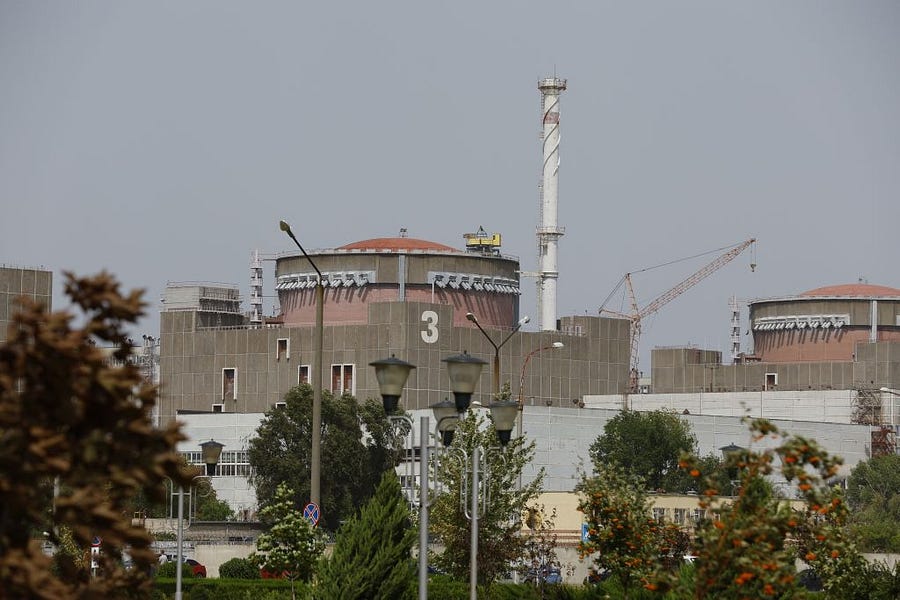Nuclear catastrophe has a way of focusing minds around the world. Before the expansion of the war in Ukraine this year, the country was still perhaps best known for being the site of the 1986 Chernobyl disaster. Vladimir Putin understands how the risk of a comparable crisis could get the world’s attention, which helps explain what has been happening at the Zaporizhzhia nuclear power plant in recent weeks.
Zaporizhzhia is the largest nuclear power plant in Europe—and it’s also located in between Europe’s largest armies as they fight the region’s fiercest war since 1945. The plant, which has twice as many nuclear reactors as America’s largest nuclear installation, was an enormous asset for Ukraine. The cheap and abundant energy produced at the plant, which is actually about 30 miles from the city of Zaporizhzhia, is one of the biggest positive legacies of the Soviet Union in a country otherwise ground down by that evil empire. But more recently it has been the site of intense shelling and even a “commando attack” by Ukrainian forces.
After the invasion began Russian troops were stopped cold outside of Kyiv and stalled elsewhere in the country, this nuclear plant was a huge prize that Russia won relatively easily by day eight. It’s particularly helpful to Russia because Crimea, seized in 2014, can’t work without Ukraine. There just isn’t enough power generation capacity in Crimea, the biggest piece of loot Russia has stolen in the past eight years, to support its development. But with Zaporizhzhia, the Russians could support their colonies and dependents in Eastern and Southern Ukraine or even export some of the power all the way to Russia. “Electric energy is a commodity that you can’t store in a warehouse,” Russian Deputy Prime Minister for Construction and Regional Development Marat Khusnullin frankly spelled out in May. “If the energy system of Ukraine is ready to accept it and pay money, then we will work [with them], if it will not accept this, then (the plant) will work for Russia.”
Like so much else in this war, taking this nuclear power plant hasn’t gone according to the Kremlin’s rosy plans. It is now close to the front lines. The Russians control only one bank of the Dnieper river here. The unoccupied Ukrainian city of Nikopol is right across the river, only 7 miles from the plant. Ukrainian artillery and special forces raids leave fewer and fewer places close to the frontlines where Russians can feel safe. The power plant, once a prize, is now a shield. The Russians placed equipment and personnel near or even within the plant, daring Ukrainians to shoot at them, according to early reports. In early August the Russians started shelling the city of Nikopol from the grounds of the plant. When the Ukrainians fire back, then Russia can propagandize about the dastardly Ukrainians risking a second Chernobyl. If the Ukrainians do not oblige, then Russian artillery can surely provide the required rockets.
Starting early last month, the plant shifted from shield to weapon. Russian propagandists have recognized that any issue touching on the nuclear power plant will automatically get headlines in the Western media. This attention keeps alive the idea of a Europe-wide threat emanating from the war. They hope this will persuade the European public to push for a ceasefire or to end support for Ukraine. The idea of the Ukrainians deliberately creating a nuclear disaster on their own soil is crazy, of course. But that didn’t stop the head of the local Russian puppet government from outlandishing claiming that the Ukrainians “wanted to carry out a terrorist attack that would lead to the spread of radiation around here and further towards Europe.”
This kind of narrative was also reiterated toward the top of the Russian hierarchy. “We have repeatedly warned our Western colleagues that if they do not bring the Kyiv regime to its senses, then it will take the most monstrous and reckless steps, the consequences of which will come back to haunt far beyond the borders of Ukraine, Russian Permanent Representative of to the U.N. Vasily Nebenzya said. “Kyiv’s criminal attacks on nuclear infrastructure facilities are pushing the world to the brink of a nuclear catastrophe comparable in scale to Chernobyl.”
The International Atomic Energy Agency sent a team of inspectors to the plant last week. Predictably, Russia released propaganda claiming it had stopped a Ukrainian sabotage team that was attempting to attack the plant while the United Nations team was on its way. On September 1, the day they arrived, Russia claimed that a Ukrainian commando team inserted via barge had tried to carry out an attack on the plant.
Photos released by Russia demonstrate the crudeness of its lies: an amphibious assault on a fortified Russian position inside Europe’s biggest nuclear power plant—using a giant pink barge? Well, it would certainly be something nobody would see coming. Footage of the inspectors at the power plant shows Russian military vehicles parked right inside key buildings, but the very best part was when one inspector used his smartphone to point out that a large rocket sticking out of the ground seems to have come from Russian-occupied territory, not from across the river. (The rocket was likely a cluster-munition dispenser that just continues on its path after it ejects its sub-munitions and tends to sink into the ground.) A Russian accompanying the delegation helpfully explained “It did a U-turn. In principle, it landed and spun around.” (You can see a video of the exchange here.)
Russia knows that if it radiates it leads. A few Russian propagandists have been quite explicit about their use of outlandish nuclear fears to get the attention of Europe. Take this article published in the major Russian news outlet RIA Novosti: “The official recognition that it is the Ukrainian regime that is ready to embark on such a monstrous provocation will not only strengthen the position of those Western politicians who doubt the need for the reckless support of Zelensky’s, but will also convince those countries that are not sure of the correctness of the Kremlin’s actions.
Russia is running low on fresh troops to throw into the Ukrainian meat grinder. Ukraine has surprising new capabilities that allow it to strike deep into Crimea and even Russia. Ukrainian morale and unity seem to be getting stronger every day. Putin may want a ceasefire—that is, a chance to lick his wounds, consolidate his gains, train more soldiers, and see what support for Ukraine looks like in the spring. The threat of a massive nuclear catastrophe at the Zaporizhzhia NPP is a means toward that end. As the situation gets worse for Russia, expect more propaganda focused on the plant. If Russia is ever forced to abandon Zaporizhzhia, what might it do on its way out to prove they were right all along?






Please note that we at The Dispatch hold ourselves, our work, and our commenters to a higher standard than other places on the internet. We welcome comments that foster genuine debate or discussion—including comments critical of us or our work—but responses that include ad hominem attacks on fellow Dispatch members or are intended to stoke fear and anger may be moderated.
With your membership, you only have the ability to comment on The Morning Dispatch articles. Consider upgrading to join the conversation everywhere.